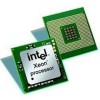Intel X5472 Specification Update - Page 29
Blocking by MOV/POP SS and Blocking by STI Bits to be Cleared in
 |
UPC - 735858201551
View all Intel X5472 manuals
Add to My Manuals
Save this manual to your list of manuals |
Page 29 highlights
Workaround: Although it is possible to have a single physical page mapped by two different linear addresses with different memory types, Intel has strongly discouraged this practice as it may lead to undefined results. Software that needs to implement memory aliasing should manage the memory type consistency. Status: For the steppings affected, see the Summary Tables of Changes. AX40. A WB Store Following a REP STOS/MOVS or FXSAVE May Lead to Memory-Ordering Violations Problem: Under certain conditions, as described in the Software Developers Manual section "Out- of-Order Stores For String Operations in Pentium 4, Intel Xeon, and P6 Family Processors", the processor may perform REP MOVS or REP STOS as write combining stores (referred to as "fast strings") for optimal performance. FXSAVE may also be internally implemented using write combining stores. Due to this erratum, stores of a WB (write back) memory type to a cache line previously written by a preceding fast string/FXSAVE instruction may be observed before string/FXSAVE stores. Implication: A write-back store may be observed before a previous string or FXSAVE related store. Intel has not observed this erratum with any commercially available software. Workaround: Software desiring strict ordering of string/FXSAVE operations relative to subsequent write-back stores should add an MFENCE or SFENCE instruction between the string/ FXSAVE operation and following store-order sensitive code such as that used for synchronization. Status: For the steppings affected, see the Summary Tables of Changes. AX41. VM Exit with Exit Reason "TPR Below Threshold" Can Cause the Blocking by MOV/POP SS and Blocking by STI Bits to be Cleared in the Guest Interruptability-State Field Problem: As specified in Section, "VM Exits Induced by the TPR Shadow", in the Intel® 64 and IA-32 Architectures Software Developer's Manual, Volume 3B, a VM exit occurs immediately after any VM entry performed with the "use TPR shadow", "activate secondary controls", and "virtualize APIC accesses" VM-execution controls all set to 1 and with the value of the TPR shadow (bits 7:4 in byte 80H of the virtual-APIC page) less than the TPR-threshold VM-execution control field. Due to this erratum, such a VM exit will clear bit 0 (blocking by STI) and bit 1 (blocking by MOV/POP SS) of the interruptability-state field of the guest-state area of the VMCS (bit 0 - blocking by STI and bit 1 - blocking by MOV/POP SS should be left unmodified). Implication: Since the STI, MOV SS, and POP SS instructions cannot modify the TPR shadow, bits 1:0 of the interruptability-state field will usually be zero before any VM entry meeting the preconditions of this erratum; behavior is correct in this case. However, if VMM software raises the value of the TPR-threshold VM-execution control field above that of the TPR shadow while either of those bits is 1, incorrect behavior may result. This may lead to VMM software prematurely injecting an interrupt into a guest. Intel has not observed this erratum with any commercially available software. Workaround: VMM software raising the value of the TPR-threshold VM-execution control field should compare it to the TPR shadow. If the threshold value is higher, software should not perform a VM entry; instead, it could perform the actions that it would normally take in response to a VM exit with exit reason "TPR below threshold". Status: For the steppings affected, see the Summary Tables of Changes. 29 Intel® Xeon® Processor 5400 Series Specification Update















